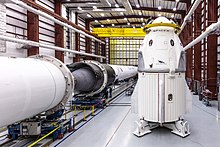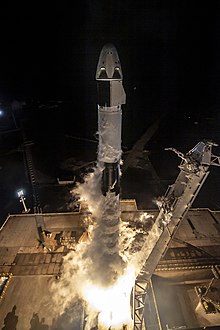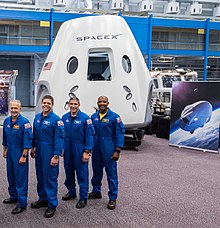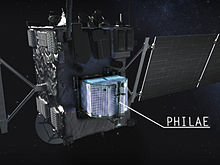
Artistic rendition of a Crew Dragon 2 approaching the International Space Station (ISS)
| |
| Manufacturer | SpaceX |
|---|---|
| Country of origin | United States |
| Operator |
|
| Applications | ISS crew and cargo transport |
| Specifications | |
| Design life |
|
| Dry mass | 9,525 kg (20,999 lb) |
| Payload capacity |
|
| Crew capacity | 7 |
| Dimensions |
|
| Volume |
|
| Production | |
| Status | Testing |
| Built | 2 (1 test article, 1 production) |
| Launched | 1 |
| First launch | March 2, 2019 |
| Related spacecraft | |
| Derived from | SpaceX Dragon |
Dragon 2 is a class of reusable spacecraft developed and manufactured by American aerospace manufacturer SpaceX, conceived as the successor to the Dragon cargo spacecraft. The spacecraft are designed for launches atop a Falcon 9 Block 5 rocket and a splashdown return. In comparison to its predecessor, it has larger windows, new flight computers and avionics, redesigned solar arrays, and a modified outer mold line. The spacecraft is used in two variants – Crew Dragon, a human-rated capsule capable of carrying up to seven astronauts, and Cargo Dragon, an updated replacement for the original Dragon. Cargo Dragon capsules are repurposed flown Crew Dragon capsules. Crew Dragon is uniquely equipped with a set of four side-mounted thruster pods with two SuperDraco engines each, which serve as a launch escape system. Both variants have been contracted for use with logistical operations of the International Space Station (ISS) under Commercial Resupply Services 2 (CRS2) and the Commercial Crew Program.
Development on Dragon 2 began as DragonRider in 2010, when NASA began searching for private operators for crewed flights to the ISS under the Commercial Crew Development program. Its design was publicly unveiled in May 2014, and in October 2014 was selected alongside Boeing's CST-100 Starliner to be developed for flight under the program. Considered by NASA as the least expensive option, US$2.6 billion was awarded to SpaceX to continue development of the spacecraft, in contrast to the US$4.2 billion awarded to Boeing. Crew Dragon's first non-piloted test flight to the ISS launched in March 2019, and its first crewed flight to the ISS is planned to occur in July 2019. Cargo Dragon was also selected in January 2016 alongside Northrop Grumman Innovation Systems' Cygnus and Sierra Nevada Corporation's Dream Chaser for cargo delivery flights under CRS2 contracts. SpaceX's initial CRS2 mission with the Cargo Dragon is slated to occur in August 2020 after SpaceX's final CRS mission with the original Dragon spacecraft, which is expected to launch no earlier than January 2020.
Development and variants
2012 DragonRider mockup, showing the launch escape system engines mounted on the outside of the capsule, when the design was not yet final.
Depictions
of the Crew Dragon's 2014 design from various angles. Visible changes
that occurred since then include the removal of the hatch and back
windows.
The DM-1 Dragon 2 capsule at SpaceX's LC-39A Horizontal Integration Facility.
Depictions of the Crew Dragon's 2019 design as in DM-1 mission
Depictions of the Crew Dragon's 2019 design as in DM-1 mission
Dragon 2 has two variants: Crew Dragon and Cargo Dragon. Crew Dragon was initially called DragonRider and it was intended from the beginning to support a crew of seven or a combination of crew and cargo.
It was planned to be able to perform fully autonomous rendezvous and
docking with manual override ability; and was designed to use the NASA Docking System (NDS) to dock to the ISS. For typical missions, DragonRider
would remain docked to the ISS for a period of 180 days, but would be
designed to be able to do so for 210 days, the same as the Russian Soyuz spacecraft. From the earliest design concepts which were publicly released in 2010, SpaceX planned to use an integrated pusher launch escape system
for the Dragon spacecraft, claiming several advantages over the tractor
detachable tower approach used on most prior crewed spacecraft.
These advantages included the provision for crew escape all the way to
orbit, reusability of the escape system, improved crew safety due to
eliminating a stage separation, and the ability to use the escape
engines during landings for a precise solid earth landing of the
capsule.
SpaceX originally intended to certify their propulsive landing
scheme, in parallel with the parachute-to-water-landing method for
Dragon 2, with the goal to hold to the development schedule and "ensure
U.S. crew transportation safely and reliably in 2017." SpaceX announced
that "land landing will become the baseline for the early
post-certification missions" while precision water landing under
parachutes was proposed to NASA as "the baseline return and recovery
approach for the first few flights of Crew Dragon."
Thus the parachute system was initially anticipated to be only a backup
system; due to the cancellation of propulsive landing, however, the parachute system will be used for all landings. As of 2011, the Paragon Space Development Corporation was assisting in developing DragonRider's life support system. In 2012, SpaceX was in talks with Orbital Outfitters about developing space suits to wear during launch and re-entry.
At a NASA news conference on May 18, 2012, SpaceX confirmed again
that their target launch price for crewed Dragon flights is $160
million, or $20 million per seat if the maximum crew of 7 is aboard, and
if NASA orders at least four DragonRider flights per year. This contrasts with the 2014 Soyuz launch price of $76,000,000 per seat for NASA astronauts. The spacecraft's design was unveiled on May 29, 2014, during a press event at SpaceX headquarters in Hawthorne, California.
In October 2014, NASA selected the Dragon spacecraft as one of the
candidates to fly American astronauts to the International Space Station
under the Commercial Crew Program. SpaceX plans to use the Falcon 9 Block 5 launch vehicle for launching Dragon 2.
Technical specifications
Dragon 2 includes the following features:
- Reusability: partly reusable; can be flown multiple times, resulting in a significant cost reduction. Dragon 2 is only planned to fly crew on the first flight of a particular capsule, while future flights of a capsule would carry only cargo.
- Capacity: 3,307 kilograms (7,291 lb) Cargo Dragon 2; seven astronauts Crew Dragon 2
- Landing: four main parachutes for water landing; possibility of developing propulsive landing using the SuperDraco engines.
- Engines (crewed variant): eight side-mounted SuperDraco engines, clustered in redundant pairs in four engine pods, with each engine able to produce 71 kilonewtons (16,000 lbf) of thrust Each pod—called a "quad" by SpaceX—contains two SuperDraco engines plus four Draco thrusters. "Nominally, only two quads are used for on-orbit propulsion with the Dracos and two quads are reserved for propulsive landing using the SuperDracos."
- Engines (cargo variant): four Draco thrusters per pod with four pods, used for orbital maneuvers.
- A 3D-printed rocket engine: the SuperDraco Engine combustion chamber is printed of Inconel, an alloy of nickel and iron, using a process of direct metal laser sintering. Engines are contained in a protective nacelle to prevent fault propagation if an engine fails.
- Docking: able to autonomously dock to space stations. Dragon V1 used berthing, a non-autonomous means to attach to the ISS that was completed by use of the Canadarm2 robotic arm. Pilots retain the ability to park the spacecraft using manual controls if needed.
- Propellant tanks: composite-carbon-overwrap titanium spherical tanks to hold the helium used to pressurize engines and also for the SuperDraco fuel and oxidizer
- Thermal protection: SpaceX-developed SPAM backshell; updated third-generation PICA-X heat shield
- Controls: static tablet-like computer and seats that swivel up to the touchscreens for optional crew control
- Cabin depressurization protection: the spacecraft can be operated in full vacuum, and "the crew will wear SpaceX-designed space suits to protect them from a rapid cabin depressurization emergency event". Also, the spacecraft will be able to return safely if a leak occurs "of up to an equivalent orifice of 0.25 inches [6.35 mm] in diameter."
- Movable ballast sled: to allow more precise attitude control of the spacecraft during the atmospheric entry phase of the return to Earth and more accurate control of the landing ellipse location.
- Reusable nose cone: "protects the vessel and the docking adaptor during ascent and reentry"; pivots on a hinge to enable in-space docking, and returns to the covered position for reentry and future launches
- Trunk: the third structural element of the spacecraft, which contains the solar arrays, heat-removal radiators, and will provide aerodynamic stability during emergency aborts.
The landing system was initially designed to accommodate three types of landing scenarios:
- Propulsive landing, for vertical takeoff, vertical landing (VTVL)
- Parachute landing, similar to prior American crewed space capsules
- Parachute landing with propulsive assist, similar to that used by the Soyuz: "The whole landing system is designed so that it’s survivable if there’s no propulsive assist at all. So if you come down chutes only with the landing legs, we anticipate no crew injury. It’ll be kind of like landing in the Soyuz."
On July 19, 2017, Elon Musk announced that propulsive landing
development had been halted and all landings would be under parachute
followed by splashdown.
The SuperDraco engines would still be used for emergency aborts, but
there would be no landing legs. The effort to qualify propulsive landing
for safety as well as the lack of technology commonalities with their
ultimate Starship was given as a reason.
However, pending approval from NASA, the SuperDraco engines can still
be used for propulsive landings in case multiple parachutes fail.
The parachute system was fully redesigned from the one used in the prior Dragon capsule, due to the need to deploy the parachutes under a variety of launch abort scenarios.
Space suit
Dragon crew members will wear a custom space suit designed to protect them during rapid cabin depressurization. It is intended to be worn only inside a pressurized spacecraft for intravehicular activities (IVA type).
For the SpX-DM1 test, a test dummy nicknamed Ripley was fitted with the spacesuit and sensors.
Planned space transport missions
Maiden flight of the Dragon 2 atop a Falcon 9.
Dragon has been designed to fulfill a set of mission requirements
that will make the capsule useful to both commercial and government
customers. SpaceX and Bigelow Aerospace are working together to support round-trip transport of commercial passengers to low Earth orbit (LEO) destinations such as the planned Bigelow Commercial Space Station.
In that use, the full passenger capacity of seven passengers is planned
to be used. SpaceX competed for a contract with NASA to deliver some
number of specific crew-transport missions to the ISS under the third
phase of the Commercial Crew Development program.
In an August 2014 presentation, SpaceX revealed that if NASA chooses to
use the Dragon 2 space capsule under a Commercial Crew Transportation
Capability (CCtCap, Commercial Crew Development) contract, then only four of the seven possible seats would be used for carrying NASA-designated passengers to the ISS,
as NASA would like to use the added payload mass and volume ability to
carry pressurized cargo. Also, all NASA landings of Dragon 2 are planned
to initially use the propulsive deceleration ability of the SuperDraco
engines only for a propulsive assist right before final touchdown, and
would otherwise use parachutes "all the way down."
On 16 September 2014, NASA announced that SpaceX, together with
Boeing, has been selected to provide crew transport ability to ISS.
SpaceX will receive $2.6 billion under this contract. NASA considers Dragon to be the least expensive proposal.
Comparing the Dragon to the Boeing CST-100, NASA's William H.
Gerstenmaier considers the CST-100 proposal the stronger of the two. In a
departure from prior NASA practice during the first five decades of the
space age,
where NASA contracted with commercial firms to build spaceflight
equipment and then NASA operated the spacecraft directly, NASA is
purchasing space transport services from SpaceX with the Dragon 2
contract, and will leave the launch, transit, and operation of the
spacecraft to SpaceX.
Crewed flights contracted to NASA
SpaceX has contracted to fly a number of crewed flights to low-Earth orbit (LEO) for the US space agency NASA. These flights are slated to begin no earlier than June 2019, with an automated test mission to the International Space Station (ISS) launched on March 2, 2019. In August 2018, NASA and SpaceX agreed on the loading procedures for propellants, vehicle fluids and crew. High-pressure helium
will be loaded first, followed by the passengers approximately two
hours prior to scheduled launch; the ground crew will then depart the
launch pad and remove to a safe distance. The launch escape system will be activated approximately 40 minutes prior to launch, with propellant loading commencing several minutes later.
Flight testing
Abort and hover tests
Pad Abort test of a Dragon 2 article on 6 May 2015 at Cape Canaveral SLC-40
SpaceX planned a series of four flight tests for the Dragon 2 that included both a "pad abort" test,
an in-flight abort test, plus both an uncrewed robotic orbital flight
to the ISS, and finally a 14-day crewed demonstration mission to the
ISS, currently planned for 2019. In August 2014, it was announced that the pad abort test would occur in Florida, at SpaceX's leased pad at SLC-40,
and the test was conducted successfully on 6 May 2015. Dragon landed
safely in the ocean to the east of the launchpad 99 seconds later.
While a flight-like Dragon 2 and trunk were used for the pad abort
test, they rested atop a truss structure for the test rather than a full
Falcon 9 rocket. A crash test dummy embedded with a suite of sensors was placed inside the test vehicle to record acceleration
loads and forces at the crew seat, while the remaining six seats were
loaded with weights to simulate full-passenger-load weight. The test objective was to demonstrate sufficient total impulse, thrust and controllability
to conduct a safe pad abort. A fuel mixture ratio issue was detected
after the flight in one of the eight SuperDraco engines, but did not
materially affect the flight. On 24 November 2015, SpaceX conducted a test of Dragon 2's hovering abilities at the firm's rocket development facility in McGregor, Texas. In a video published by the firm, the spacecraft is shown suspended by a hoisting cable and igniting its SuperDraco
engines. The capsule hovers in equilibrium for about 5 seconds, kept in
balance by its 8 engines firing at reduced thrust to compensate exactly
for gravity.
The video shows the second test of the two-part milestone under NASA's Commercial Crew Development
contract with SpaceX. The first test, a short firing of the engines
intended to verify a healthy propulsion system, was completed two days
earlier on 22 November. The test vehicle was the same capsule that
performed the pad abort test earlier in 2015; it was nicknamed DragonFly.
SpaceX plans to conduct an in-flight abort test from Kennedy Space Center Launch Complex 39A in Florida after the first uncrewed orbital test flight and prior to the first crewed test flight. The test is planned to be conducted approximately in June 2019 with the refurbished capsule from the uncrewed test flight. Earlier, this test had been scheduled before the uncrewed orbital test,
however, SpaceX and NASA consider it safer to use the more recently
designed capsule rather than the older test article from the pad abort
test. The Dragon 2 test capsule will be launched in a sub-orbital flight to conduct a separation and abort scenario in the troposphere at transonic velocities, at max. Q, where the vehicle experiences maximum aerodynamic pressure.
The test objective is to demonstrate the ability to safely move away
from the ascending rocket under the most challenging atmospheric
conditions of the flight trajectory, imposing the worst structural
stress of a real flight on the rocket and spacecraft.
The capsule will then splash down in the ocean with traditional
parachutes, possibly with assistance of its integrated thrusters to
smooth the final moments of the descent. The in-flight abort capsule was
originally planned to launch on F9R Dev2 before the Falcon 9 Full Thrust
vehicle (and its densified propellants) made F9R Dev2 incompatible with
both of SpaceX's active orbital launch pads. Then a special version of
the Falcon 9 first stage with just three engines was prepared for this
test and carried to the launch pad at Vandenberg in April 2015 to
conduct a tanking test. It was erected on the revised and rebuilt
transporter erector (TE) and fully loaded with propellants on 9 April
2015 to test both the vehicle and ground support equipment.
Those plans were later scrapped, and the abort test will be performed
using an entire Falcon 9 Block 5 rocket and will be used as a test of
the fueling procedure in order to human-rate the Falcon 9 rocket for
NASA's Commercial Crew Program.
Orbital flight tests
Crew
Dragon 2 mockup (background) and the astronauts selected for its first
two crewed missions (foreground), from left to right: Douglas Hurley,
Robert Behnken, Michael Hopkins and Victor Glover.
In 2015, NASA named its first Commercial Crew astronaut cadre of four veteran astronauts to work with SpaceX and Boeing – Robert Behnken, Eric Boe, Sunita Williams, and Douglas Hurley. The SpX-DM2
mission will complete the last milestone of the Commercial Crew
Development program, paving the way to starting commercial services
under an upcoming ISS Crew Transportation Services contract. On August 3, 2018 NASA announced the crew for the DM-2 mission. The crew of two will be formed by NASA astronauts Bob Behnken and Doug Hurley.
Behnken previously flew as mission specialist on the STS-123 and the
STS-130 missions. Hurley previously flew as a pilot on the STS-127
mission and on the final Space Shuttle mission, the STS-135 mission.
The first orbital test of Crew Dragon 2 was an uncrewed mission, designated SpX-DM1 and launched March 2, 2019. The spacecraft tested the approach and automated docking procedures with the ISS,
remained docked until March 8, 2019, then conducted the full re-entry,
splashdown and recovery steps to qualify for a crewed mission.
Life-support systems were monitored all along the test flight. The same
capsule will be re-used in June for an in-flight abort test. As of February 2019, Dragon 2 is scheduled to carry its first crew of two NASA astronauts on a 14-day test-flight mission to the ISS in July 2019.
List of missions
List includes only completed or currently manifested missions. Launch dates are listed in UTC.
| Mission | Capsule № | Launch date (UTC) | Remarks | Time at ISS (dd hh mm) | Outcome |
|---|---|---|---|---|---|
| Dragon 2 pad abort test | DragonFly | 6 May 2015 | Pad abort test, Cape Canaveral Air Force Station, Florida | N/A | Success |
| SpX-DM1 | C201 | 2 March 2019 | Uncrewed test flight of the Dragon 2 capsule; Docked 3 March 0851 UTC, Departed 8 March 0532 UTC | 4:21:17 | Success |
| Dragon 2 in-flight abort test | C201 (reused capsule) | June 2019 | The in-flight abort test will be conducted with the refurbished capsule from the uncrewed test flight. | N/A | Planned |
| SpX-DM2 | C203 | July 2019 | Crewed test flight of the Dragon 2 capsule, with two astronauts for two weeks |
|
Planned |
| CCtCap Missions 1–6 |
|
2019 and after | First operational crew transport mission with Dragon 2. Pending success of SpX-DM1 and SpX-DM2, NASA has awarded six missions with Dragon 2.0 to carry up to four astronauts and 220 pounds of cargo to the ISS as well as feature a lifeboat function to evacuate astronauts from ISS in case of an emergency. |
|
Planned |
| CRS2 missions 1–6 |
|
2020–2024 | NASA has awarded SpaceX six more cargo missions under the CRS2 contract. Those missions were originally scheduled to begin in 2019 but were delayed. |
|
Planned |















